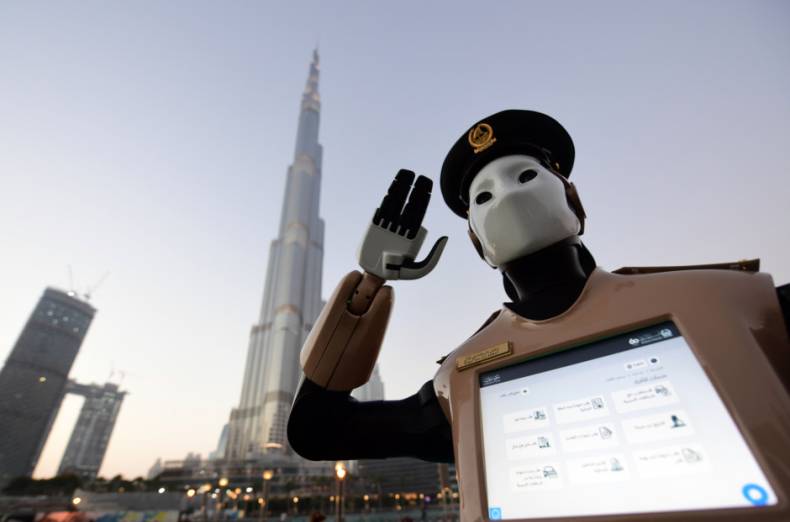Robots and AI: Our New Lawyers, Police, and Dentists?
Increasingly more capable robots and artificial intelligence systems are capable of even more complex jobs that normally would require years of post-secondary training for a human to do. Here are a few examples in law, law enforcement, and dentistry.
AIs and robots are making their way into increasingly skilled positions in the workforce. Here are some examples of how machines are being used in industries that push the limits of machine learning and open new doors to how we use AI in everyday life.
Robots are expected to be able to replace workers in many industries. At present, the positions are largely relatively low-skill in nature—cashiers, manufacturing, and assembly. However, increasingly more capable robots and artificial intelligence systems are capable of even more complex jobs that normally would require years of post-secondary training for a human to do.
So far, these systems work in tandem with a human professional, but perhaps there will be a time when highly qualified personnel could be replaced too. Check out how artificial intelligence and robotics are being used in jobs that are surprisingly high-skill.
Ross, IBM's Cognitive Computer Legal Assistant
Ross is an IBM cognitive computer hired by law firm BakerHosteler in the bankruptcy division. Working with around 50 other human lawyers, Ross can understand natural language and communicate with human lawyers to hypothesize and research legal cases, including providing latest information and news on related cases.
Ross has also been helpful in scanning through large amounts of data and then identifying the most relevant citations. This, already, can save lawyers significant time and keep them on the cutting edge of information. Ross continually learns, so the system’s capabilities develop and grow as it does more work.
IBM's Watson, a cognitive computer, has already been previously employed in the workforce, mostly in retail and hospitality. It's also appearing in the finance and healthcare sectors, as well. Watson was designed to be a “question answering” system which can understand natural language. After a question is posed to it, it is able to contextualize and provide accurate responses—it doesn’t just search a database for keywords.
The video below from IBM explains how Watson works.
New Members of the DPD
Dubai wants to expand its police force so that up to 25% of it is composed of robots—the head of the Smart Services division of the police department in Dubai emphasized that the robots will not be replacing humans in the force, but are complementary additions.
However, the robot police won’t be chasing down suspects and making arrests—they will mostly be used for patrol in areas with high tourism and providing police assistance 24/7. The touchscreen on the robot’s chest can allow users to pay fines, report crimes, or request for help and built-in cameras allow central police stations to monitor areas. The robot can also assist in several languages, such as Arabic and English.
The robotic branch of the police force will allow human police officers to focus their efforts on more complex duties, while still permitting the DPD to provide police presence and assistance in other areas around the clock.
The robot are modified versions of the REEM robot, humanoid robots built by PAL-Robotics for industry and research. REEM is approximately 5’6”, 220lbs, an 8 hour battery life (hot-swap enabled), with advanced navigation capabilities that allow it to move in crowded environments.

The Dubai Police Robots won't replace human police, but will work with them in the force. Image courtesy of GulfNews.
Sitting in the Robot Dentist's Chair
Mainland China is facing shortages of qualified and skilled surgeons with millions of people requiring dental surgery. Compounding the shortage is the reportedly high frequency of mistakes made during routine operations. These mistakes can further complicate dental problems.
In response, a military university in Xian and a robotics institute in Beijing paired together to develop a robot that can perform dental surgeries. The project took five years to develop before the first operation was carried out autonomously on a human.
The robotic dentist’s premiere operation involved implanting 3D printed artificial teeth in a human. It did so without any human intervention whatsoever, and with an accuracy of 0.2-0.3mm error, within the tolerance required for a successful operation. It was also able to adjust for patient movement and could work better than a human in the enclosed mouth space.
The Human Impact
How robots and artificial intelligence will impact the human workforce is a discussion that can be highly polarizing since it involves the livelihood of people. There have been plenty of suggestions made on how the loss of jobs can be made up: robotic/system maintenance and design will create jobs, suggestions of a basic universal income, or even taxing robot employees to name a few.
What will be the right or best approach is still to be seen. However, at this time, we can clearly correlate that adding advanced robotics and AI to the workforce can help speed up processes, reduce mistakes, and free up resources.







